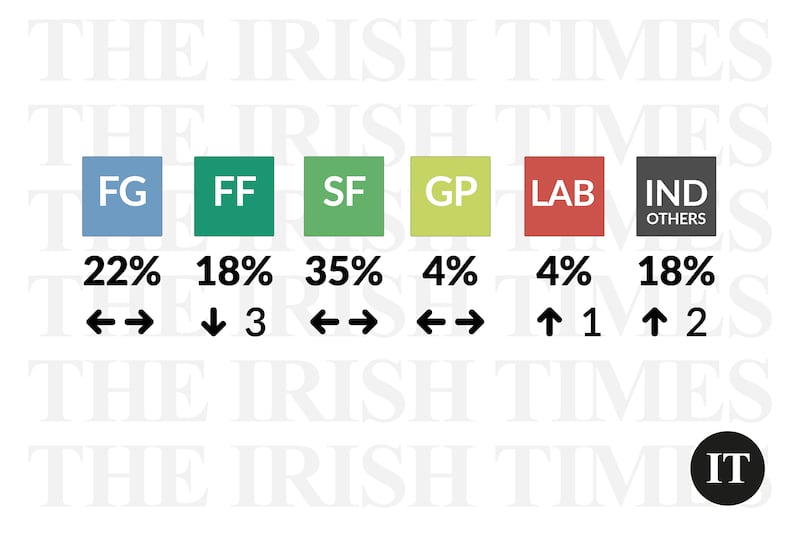Just because a poll doesn’t feature many changes doesn’t mean it isn’t important and instructive. Today’s poll shows only one movement outside the margin of error in party support — a three-point drop for Fianna Fáil — but it tells us much about the state of political competition and the disposition of forces on the political landscape.
First things first: the poll confirms the popularity of Sinn Féin as the number one party countrywide in political support, by some considerable distance. The party is 13 points ahead of its nearest rivals in Fine Gael and 17 ahead of Fianna Fáil.
Every Irish Times/Ipsos poll since the middle of 2021 has shown that Sinn Féin is on track to be the largest party in the next Dáil. And while the next general election may still be two years away, there is no sign that this trend is anything other than rock solid.
The party might privately cavil that its leader’s satisfaction rating slips a little today, or that at a time when the cost of living is squeezing people hard, it is not making further headway over its rivals. That is not, however, to deny the extraordinary progress the party has made under its current leader, moving right to the centre of Irish politics and justifiably preparing for participation in government.
RM Block
What the poll does not tell us, however, is what the party’s route to government might be. There are two basic options. The preferred one is at the head of a left-wing coalition, encompassing Labour, the Social Democrats, the Greens and, if necessary, some left-wing Independents. That presumes a willingness to serve on the part of all these partners and it presumes the numbers are there to constitute a Dáil majority. Both are contestable assumptions and, judging by the results of today’s poll, somewhat unlikely on the numbers front.

Sinn Féin’s other potential route to government involves a Coalition with Fianna Fáil. On the evidence of today’s poll, those parliamentary numbers would work; indeed, they might well be the most straightforward route to a Dáil majority after the next election. But would it be politically possible? That is not a question to which there is a certain answer yet. Even assuming Sinn Féin wants it — probably a reasonable bet — it is unclear what Fianna Fáil’s attitude will be. The answer to that question relies on variables such as the party’s leader, its performance in the election, and whether it has other options.
Fianna Fáil’s confidence about the future will not be bolstered by today’s results. The party has trundled along in the low 20s since the middle of 2020 but slips below that benchmark today to 18 per cent. The move coincides with leader Micheál Martin’s departure from the Taoiseach’s office and the loss of the attendant profile as the Government’s chief representative and spokesman. Despite Martin’s relatively high approval ratings — he is the most popular of the party leaders, albeit by a small margin — the reality is that it will become harder for the party to get across its message. Its support remains heavily skewed towards older voters.
Taken altogether, however, it is not a disastrous poll for the Government as a whole. Fine Gael and the Greens hold their own, satisfaction slips only slightly and the number of people who believe the Republic is on the wrong track has not grown substantially since October.
In circumstances where the State is in the grip of a cost-of-living squeeze, a chronic shortage of housing, where it is a daily struggle to accommodate refugees fleeing war in eastern Europe and where the Government endures a daily pummelling on a variety of issues including, but not limited to, all of the above — almost holding your own is not that bad a result.
Mixed messages, as ever, are evident for the smaller parties in the data. Labour and the Greens are on 4 per cent each, a rating which is steady for the Greens and a one-point gain for Labour. Slight, within-the-margin-of-error declines for the Social Democrats (from 3 to 2 per cent), Solidarity-People Before Profit (from 2 to 1 per cent) while Aontú falls to below 1 per cent. Independents reap the benefit, up from 10 per cent in October to 14 per cent today.
But as we note every time we publish an opinion poll, national polls are not the best measure of the likely electoral fortunes of smaller parties, which rely on a small number of strong candidates in a handful of constituencies. Opinion poll ratings are not unimportant for them, of course, for reasons of morale and momentum. But it’s important to understand their limitations.
Finally, there is a substantial uptick in the number of undecideds in today’s poll — up from 23 per cent in October to 28 per cent today. And that follows an increase of three points in the October poll.
It is not inconsistent with the picture of a political landscape which is relatively stable, but in which there are a large number of voters who may be swayed before they cast their votes. The forthcoming period of political competition will be intense.












